The discomfort of dry eyes can be more than just a minor irritation. This common condition can lead to various symptoms that significantly impact your daily life. One important symptom of dry eyes can be blurry vision.
Typically, dry eye symptoms are easily treatable. However, dry eye can also be a chronic condition requiring more than at-home remedies, so it’s essential to involve your eye doctor if you experience persistent symptoms. They can recommend effective treatments and offer tailored advice.
Understanding Dry Eyes
Dry eye syndrome, or dry eye, occurs when the eyes do not produce enough tears or when those tears evaporate too quickly. Tears are essential for maintaining the health of the front of the eye and for providing clear vision. Without adequate lubrication, your eyes can become dry, irritated, and inflamed.
Common Symptoms of Dry Eyes
Dry eyes can present with a variety of symptoms, including:
- A stinging, burning, or scratchy sensation in your eyes
- Sensitivity to light
- Redness in the eyes
- A sensation of having something in your eyes
- Difficulty wearing contact lenses
- Difficulty with nighttime driving
While these symptoms are bothersome, they can also lead to other vision-related issues, such as blurry vision.
The Link Between Dry Eyes & Blurry Vision
Blurry vision can occur in conjunction with dry eyes due to the instability of the tear film on the cornea. The tear film is crucial for clear vision, as it maintains the smoothness of the eye’s surface. When the tear film is disrupted, it can cause fluctuations in vision.
The Impact of Digital Devices & Environmental Factors
Certain environmental factors and screen time can significantly contribute to dry eyes and blurry vision.
Screen Time & Blinking
People tend to blink less frequently when using digital devices. And blinking is vital for spreading tears evenly across the eyes’ surface. Reduced blinking can lead to tear evaporation and dry patches, resulting in blurry vision. Taking regular breaks from screens and practicing the 20-20-20 rule (every 20 minutes, look at something 20 feet away for at least 20 seconds) can help maintain eye moisture.
Environmental Factors
Dry environments, whether from air conditioning, heating, or wind, can accelerate tear evaporation. A humidifier can add moisture to the air, helping to alleviate dry eyes. Protecting your eyes with wraparound sunglasses in windy or dry conditions can prevent excessive tear evaporation.
Management & Prevention Tips
While dry eyes and blurry vision can be frustrating, there are several strategies to manage and prevent these issues effectively.
- Stay hydrated: Drinking plenty of water helps maintain overall eye moisture.
- Balanced diet: Foods rich in omega-3 fatty acids, such as salmon and flaxseeds, support healthy tear production.
- Regular breaks: Taking frequent breaks from screen time and reducing exposure to dry environments can help keep your eyes comfortable.
Eye Care Routine
Implementing a consistent eye care routine can make a significant difference. This includes:
- Warm compresses: Applying a warm compress to your closed eyelids can help stimulate oil glands and improve tear quality.
- Eyelid hygiene: Cleaning your eyelids with a gentle cleanser can reduce inflammation and promote healthier tear production.
- Artificial tears or lubricating eye drops: These products help supplement your natural tear film, alleviate dryness, reduce blurriness, and relieve temporary symptoms.
Professional Advice & When to Seek Help
If you experience persistent dry eyes and blurry vision, it’s essential to consult an eye care professional. They can provide a comprehensive evaluation and recommend treatments tailored to your specific needs.
Medical Treatments
A few in-office or prescription dry eye treatments are:
- Prescription eye drops: Your eye doctor may prescribe anti-inflammatory eye drops to reduce inflammation and improve tear production.
- Punctal plugs: These tiny plugs can be inserted into the tear ducts to reduce tear drainage, keeping your eyes moist for longer.
- Optiplus Radiofrequency: It uses radiofrequency to unclog meibomian glands and produce collagen in the eyelids.
- OptiLight: OptiLight by Lumenis is a safe, gentle, and effective treatment for dry eye symptoms. It uses IPL technology to treat meibomian gland dysfunction. Your eye doctor can determine whether this could be a beneficial treatment for your dry eye symptoms.
When to Seek Help
If over-the-counter remedies and lifestyle changes don’t alleviate your symptoms, or if you experience severe or worsening vision problems, it’s crucial to seek professional medical advice. Early intervention can prevent further complications and improve your quality of life.
Discuss Your Symptoms with Your Eye Doctor
Dry eyes are more than just a minor inconvenience—they can significantly impact your vision and overall well-being. By understanding the connection between dry eyes and blurry vision, recognizing the symptoms, and implementing effective management strategies, you can take proactive steps to maintain clear and comfortable vision.
Remember, if you experience persistent symptoms or if your vision continues to be affected, consult your eye doctor. Call our team at Eyes on Plainville today to book an exam. One of our experienced optometrists, Dr. Gaan or Dr. Perriello, can examine your eyes and offer you effective treatment options and tailored advice.





